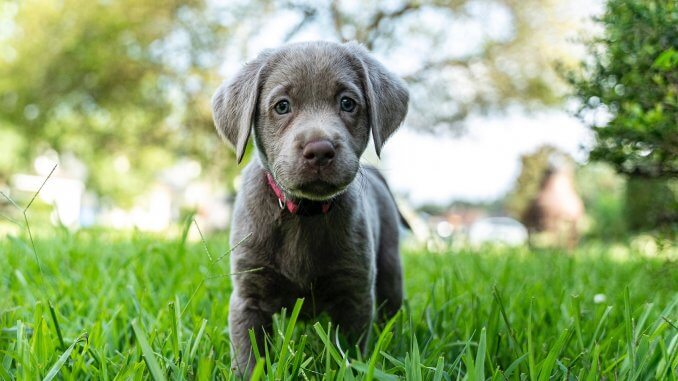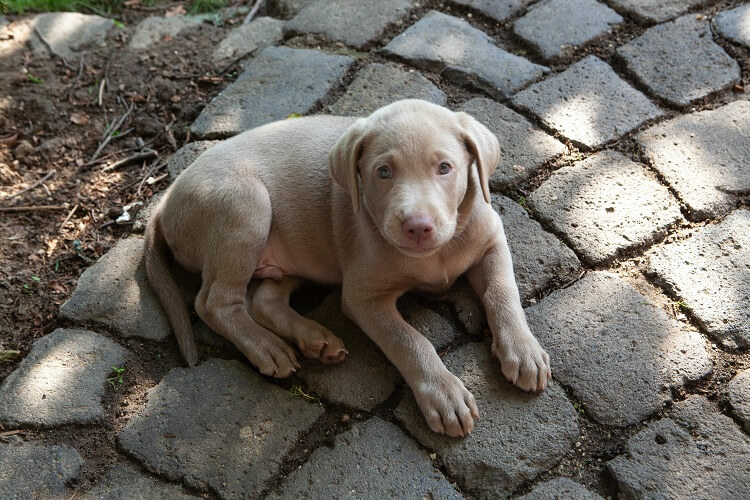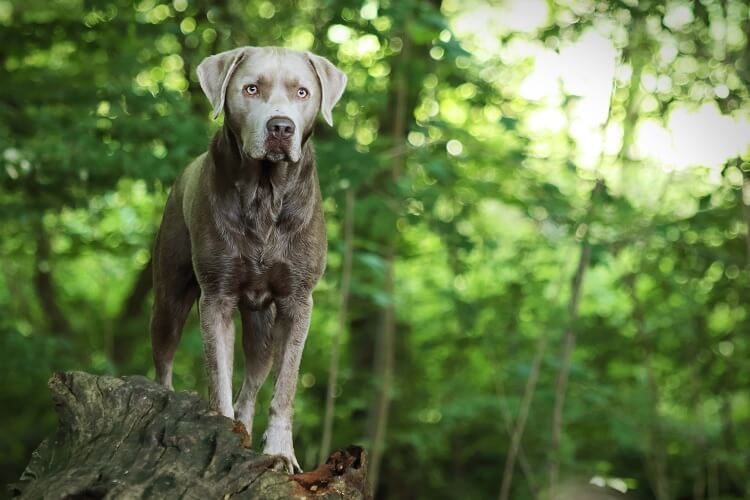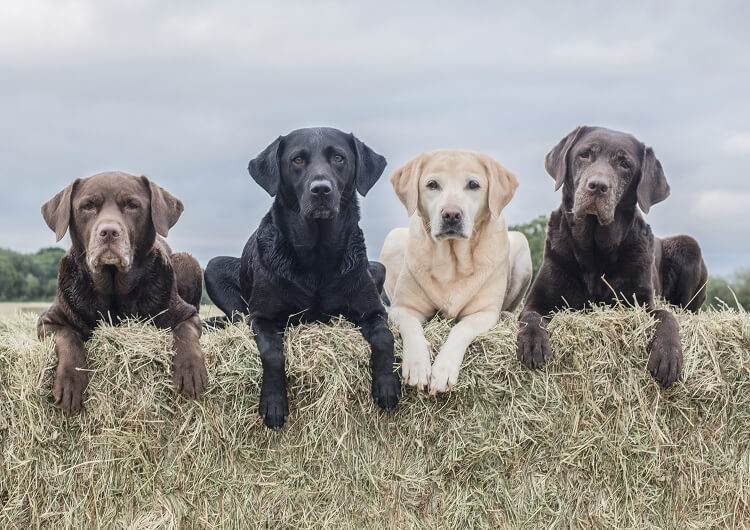Labrador Retrievers can come in many colors, but have you ever seen a Silver Lab?
A few years ago, while volunteering at a local rescue center, my best friend Alex, a renowned geneticist specializing in canine genetics, stopped by for an educational session. As we were all huddled around, eager to learn, Alex began, “You’re all familiar with the standard colors of Labs, but there’s a unique variation that’s both fascinating and somewhat controversial — the Silver Lab.”
With everyone’s attention piqued, he continued, “Their distinct color comes from a dilute gene, which lightens the coat. Originally, they were considered Chocolate Labs with a diluted gene, but over time, they’ve become recognized as Silver.”
His words had me reading further on the topic to learn more about this breed.
You see, Silver Labs are beautiful slate gray Labrador Retrievers with the same friendly and happy personality as regular Labs. Keep reading to learn everything you need to know about these beautiful dogs.
TABLE OF CONTENTS
- Silver Lab Quick Breed Summary
- Physical Characteristics of a Silver Lab
- Silver Labrador Origins
- Silver Lab Personality and Temperament
- A Day in the Life of Silver Labs
- Silver Labrador Retriever Care Guide
- Silver Labrador Retriever Health Issues
- How Much Does a Silver Lab Cost?
- FAQs on Silver Labs
- A Grey Labrador is Unique
Silver Lab Quick Breed Summary
Physical Characteristics of a Silver Lab
From Adobe Stock
The first thing you’ll notice about this breed is its stunning silver coat, which captures the eye with its unique hue. I’ve always been fascinated by the way their smooth double coat glistens, almost like velvet, in either slate grey or a faded brown. It’s not just their coat that makes them stand out; they embody the strong and lean physique typical of Labs, complete with long floppy ears and those gentle dark eyes that seem to look right into your soul.
One feature that always gets my attention is their straight otter tail. It’s not just for show; this tail is a powerful tool that allows the dog to maneuver safely through water. Having spent countless hours at rescue centers and with various breeds, I’ve come to appreciate how well Silver Labs are built for both land and water, boasting long muscular legs perfect for running and swimming.
Size
Understanding the growth progression of a Lab puppy offers fascinating insights into their development. When your puppy is between 7 to 12 weeks old, you can expect them to weigh anywhere from 10 to 22 pounds, showcasing the rapid growth phase typical of this breed. As they transition into the next phase of their puppyhood, between 12 weeks and 6 months, they experience a significant growth spurt, reaching about half of their adult weight, which is approximately 40 pounds.
This pace continues as they grow older, with puppies aged 6 to 9 months hitting three-quarters of their adult size, tipping the scales between 50 and 65 pounds. By the time they celebrate their first birthday, they will have reached their full adult weight, which ranges between 55 to 80 pounds, depending on factors like genetics, diet, and overall health. It’s quite the sight to see them in their full glory, with males tipping the scales between 65 and 80 pounds and females slightly lighter at 55-70 pounds.
Colors
The color spectrum of the Silver Lab is fascinating, ranging from shades of slate or bluish-gray to faded brown. Each time I stroke their smooth, velvet-like coat, it reminds me of the breed’s unique beauty and resilience. Their coat isn’t just for looks; it’s waterproof and provides them protection from the cold, a testament to their adaptability. It’s intriguing how all Silver Labs must be registered as Chocolate Labs to gain AKC recognition, a detail that often sparks conversations among professionals and enthusiasts about the breed’s heritage and classification.
Silver Labrador Origins
From Adobe Stock
The story of the Labrador Retriever, tracing back to Newfoundland, Canada, near the province of Labrador, has always fascinated me, especially given the debate surrounding its origins. Despite the mysteries of their exact beginnings, it’s widely acknowledged that they were bred to be unparalleled hunting partners and game bird retrievers. My admiration for these dogs deepened when I learned how they captured the world’s attention in the 19th Century, thanks to the English who introduced them globally. Silver is not the only unusual fur color in the standard Retriever. For instance, the Red Fox Lab sports a darker variant of the Yellow fur color and looks rusty red.
The recognition of Black and Yellow Labs by the American Kennel Club in 1917 marked a significant milestone. However, the journey of the Silver Lab, which began in the early 1920s, introduced a new chapter filled with controversy. Plus, the Chocolate color once considered a flaw due to its recessive status and associated health concerns, set the stage for an even more contentious debate with the emergence of the Silver Lab.
In addition, the dilute gene that Silver Labs carry can also cause bluish-gray colors in other breeds such as French Bulldogs and Weimaraners. It’s this resemblance between Silver Labs and Weimaraners that fueled rumors of crossbreeding rather than pure lineage.
Despite ongoing debates about their pedigree, Silver Labs’ inability to compete in AKC dog shows, contrasted with their eligibility for other events, underscores the complex relationship between breed standards and genetic diversity. Through conversations with fellow animal behaviorists and hours spent volunteering at rescue centers, I’ve come to appreciate the nuanced perspectives on what defines a purebred dog.
Silver Lab Personality and Temperament
From Adobe Stock
These dogs are the epitome of companionship, blending the innate friendliness and joyful disposition characteristic of all Labrador Retrievers with a unique charm that’s all their own.
From my experience, Silver Labs exhibit an unwavering loyalty to their families. They thrive on interaction and are happiest when they’re part of daily activities, whether that’s a quiet evening at home or an adventurous outing. Their sociable nature means they get along splendidly with children and other pets, making them ideal family dogs. I’ve seen first-hand how gently they interact with kids, showing patience and a protective instinct that’s heartwarming to witness.
Another aspect of their temperament that always impresses me is their intelligence and eagerness to please. Training sessions with Silver Labs are not just productive; they’re a joy. These dogs pick up on commands quickly, and their desire to make their humans happy makes them responsive and easy to train. Whether it’s basic obedience or more complex tricks, Silver Labs approach learning with enthusiasm and a keen mind.
However, it’s their playful and energetic nature that truly stands out. They have a zest for life that’s infectious. Whether chasing a ball in the backyard, hiking alongside you, or enjoying a swim, Silver Labs are always up for an adventure. Their love for physical activity not only makes them great companions for active individuals and families but also highlights the importance of providing them with ample exercise to keep them healthy and content.
But it’s not all about high energy and play; Silver Labs also have a tender side. They’re incredibly affectionate, often seeking out cuddles and pats, demonstrating their love in the most heartwarming ways. Their expressive eyes and gentle demeanor have a way of melting away the stresses of the day, reminding me why dogs are such cherished companions.
A Day in the Life of Silver Labs
Waking up to a Silver Lab’s morning routine, as shared by many friends who are lucky enough to have one, is something quite special. They tell me how their Labs are up with the dawn, eagerly nudging them awake with wet kisses and a nudge of the nose, signaling it’s time to start the day.
After breakfast, which seems to be a highlight for these enthusiastic dogs, my friends often share how their Silver Labs become the most loyal shadows, following them from room to room as they get ready for the day. It’s a testament to the breed’s renowned companionship and loyalty.
The anticipation for the morning walk is a universal trait, it seems. Friends have laughed, telling me how their Labs bring them the leash, a clear signal of their eagerness to explore the outside world. Those walks, whether through bustling streets or peaceful parks, are cherished moments that help strengthen the bond between them.
When it’s time for work, I’ve been told how Silver Labs will settle into their crates, the morning’s exercise helping them calm down for a quiet day at home. The joyous reunion at day’s end is something all of them look forward to, greeted by an explosion of joy and affection that melts away any stress.
Evening routines are just as filled with activity and companionship, from playful antics in the backyard to peaceful walks that help both dog and owner unwind. The adventures don’t stop there; weekends and holidays offer even more opportunities for exploration and fun, be it a beach day or a playdate with fellow canine friends.
As the day winds down, I hear about the domestic bliss that comes with having a Silver Lab. They describe how their dogs eagerly join them on the couch, ready for a quiet evening together. At bedtime, these loyal companions find their spot, often at the foot of the bed, ensuring they’re close to their humans even as they sleep.
Silver Labrador Retriever Care Guide
From Adobe Stock
A Silver Lab dog never asks for much. Other than its high activity level and need for mental stimulation, this breed’s needs are very basic (even children can learn to care for one). Here are some guidelines.
Feeding
From my experience and the advice I’ve gathered over the years, understanding the nutritional needs of a Silver Lab dog at various stages of life is crucial. Let me break down some of the key guidelines for feeding these magnificent dogs.
Choose the Right Food
When it comes to what to feed your (Silver)Grey Labrador, high-quality kibble is always a solid choice. It’s formulated to provide a balanced diet, containing the necessary vitamins and minerals for your dog’s health. However, if you prefer to mix things up, incorporating wet or raw food is also an option. Replacing one cup of kibble with a can of wet food or a raw cut of chicken or turkey can add variety to their diet. However, it’s important to remember never to feed raw beef or pork to a dog, as these can pose health risks.
Portion Control for Different Life Stages
Puppies: Silver Lab puppies are bundles of energy and require a diet rich in protein to support their rapid growth. They should be fed more frequently, about three to four times a day, in smaller portions. This helps sustain their energy levels and supports healthy development.
Adults: Once fully grown, a Silver Retriever typically needs about 800 to 1200 calories per day, depending on their activity level. For most adult Silver Labs, two meals a day is a good routine. This helps prevent overeating and maintains their weight at a healthy level.
Seniors: As they age, Silver Labs may become less active and their metabolic rate may slow down. It’s important to adjust their diet accordingly, reducing calorie intake to prevent obesity. Senior-specific dog food, which is lower in calories but still rich in nutrients, is often recommended.
Nutritional Balance
Protein should indeed be the cornerstone of your Lab’s diet, as it’s essential for muscle development and repair. Look for foods where protein sources, such as chicken, turkey, or fish, are listed as the primary ingredient. Healthy fats are also important for energy and coat health, while carbohydrates, though necessary, should be lower on the list. Opt for foods where carbs come from natural sources, like vegetables and whole grains, rather than artificial fillers or sugars.
Grooming
Grooming a Silver Lab is an essential aspect of their care that shouldn’t be underestimated. Despite their short fur, they’re not a low-shed breed, something I’ve learned through conversations with fellow dog enthusiasts. You’ll find silver hairs on your couch and carpet, a small price to pay for the joy these dogs bring into your home.
Weekly Brushing
Throughout most of the year, Silver Labs shed moderately. To keep their coat healthy and reduce the amount of hair around your house, a weekly brushing session is necessary. This routine not only helps manage shedding but also strengthens the bond between you and your pet.
Seasonal Shedding
During the shedding seasons of spring and fall, Silver Labs shed more heavily as they prepare their coats for the changing weather. During these times, it’s beneficial to add an extra day of brushing to your routine. This ensures their coat remains neat and minimizes the amount of hair shed around your home.
Nail Care
Active Silver Labs often naturally wear down their nails, reducing the need for frequent trims. However, it’s still important to check their nails every two weeks. Trimming is only necessary if the nails begin to curl or if they’re not being worn down adequately through regular activity.
Dental Health
Dental care is a critical, yet frequently overlooked, component of grooming. At least once a week, you should brush your Silver Lab’s teeth to prevent dental diseases and keep their breath fresh. Using flavored toothpaste can make this a more enjoyable experience for your dog, encouraging them to look forward to brushing sessions.
Training and Exercise
From Adobe Stock
Training and exercising a Silver Lab dog is rewarding and essential for their well-being. These dogs are known for their intelligence and energy, traits that, when properly channeled, can lead to a harmonious and joyful living situation.
Exercise
Every Silver Lab needs daily exercise to stay healthy and happy. I’ve found that a combination of physical activities, such as long walks, runs, or even a game of fetch in the backyard, greatly contributes to their overall well-being. Swimming is another fantastic way to exercise them, given their breed’s natural affinity for water. It’s not just about keeping them physically fit; these activities also strengthen the bond between you and your dog. Aim for at least an hour of exercise daily, but adjust based on their energy level and health. Remember, a tired Silver Lab is a happy Silver Lab.
Training
Their eagerness to please and quick learning ability make them excellent candidates for both basic obedience and more complex commands. Starting training early is key, utilizing positive reinforcement techniques such as treats and praise to encourage good behavior. Consistency and patience are crucial; regular short training sessions are more effective than occasional longer ones. Labrador training also extends beyond commands, involving leash manners and polite greeting behaviors, which are essential for such a sociable breed.
Mental Needs
Addressing the mental needs of a Silver Lab is as important as their physical exercise. These intelligent dogs thrive on mental stimulation to prevent boredom and destructive behaviors. Puzzle toys, scent games, and training challenges are great ways to keep their minds active. I’ve noticed that engaging them in activities that require problem-solving not only entertains them but also enhances their learning abilities. Incorporating daily mental exercises into their routine ensures a well-rounded and satisfied dog.
Socialization
Socialization is crucial for Silver Labs, a point that becomes clear when you witness their joy in meeting new people and dogs. Early exposure to different environments, animals, and people helps them develop into well-adjusted adults. Organized playdates, visits to dog parks, and even dog-friendly public places are excellent for socializing your Lab. From my experience, well-socialized Silver Labs are more confident, less prone to anxiety, and display better behavior in various situations.
Silver Labrador Retriever Health Issues
From Adobe Stock
Caring for a Silver Lab, much like Labradors in classic fur colors like chocolate or yellow, comes with its set of challenges, particularly when it comes to health. Through my years of being involved with dogs and speaking to countless owners and veterinarians, I’ve gained insight into the common health issues this breed faces and how best to manage them.
Joint Issues
I’ve seen many Silver Labs, given their size and energy levels, are prone to joint issues such as hip and elbow dysplasia. This condition can limit their mobility and, in some cases, lead to arthritis. Regular vet check-ups and maintaining a healthy weight through proper diet and exercise can mitigate the risk. Supplements like glucosamine and chondroitin are often recommended by veterinarians to support joint health. It’s heartbreaking to see a dog struggle with mobility, so early intervention is key.
Eye Conditions
Eye conditions are another health aspect I’ve noticed in Silver Labs. Conditions like progressive retinal atrophy (PRA) and cataracts can significantly affect their quality of life. Regular eye exams during veterinary check-ups can help catch these conditions early. The thought of our furry friends losing their sight is distressing, but with early detection, many eye conditions can be managed effectively.
Exercise-Induced Collapse (EIC)
Exercise-Induced Collapse (EIC) is somewhat common in the breed, from what I’ve gathered through conversations with other owners. This genetic condition can cause dogs to collapse after periods of intense exercise. Understanding your dog’s limits and watching for signs of overexertion can prevent episodes. It’s a condition that reminds us of the importance of knowing our pets’ health as intimately as their personalities.
Obesity
Obesity is a health issue I’ve frequently seen discussed among Silver Lab owners. Their love for food and potential for overeating can lead to excessive weight gain, exacerbating joint problems and leading to other health complications like diabetes. Monitoring their diet, providing regular exercise, and avoiding too many treats are straightforward but effective strategies to prevent obesity. Seeing a dog regain its vitality by shedding extra weight is incredibly rewarding.
How Much Does a Silver Lab Cost?
From Adobe Stock
This color is considered a luxury color. In addition, it is very rare and difficult to breed for.
There is no guarantee of the dilute recessive gene in a litter of puppies. Most of the time a Silver Lab is a rare find in a Chocolate or Black litter. All of these factors contribute to the puppy’s high price tag — a Silver Lab puppy will cost anywhere between $1000 and $1500.
Silver Lab Dog Buyer’s Tips
Here’s a simple checklist to help you plan and buy a Silver Labrador:
- A Silver Lab will be more expensive than other more common colors, so you will need to budget accordingly. Expect to pay anywhere from $1000 to $1500 for your new puppy.
- This color is more susceptible to health problems than other colored Labs so a good pet insurance plan is worth considering.
- Unethical breeding practices are common for specialty colors like this. Make sure to beware of bargains that sound too good to be true.
- Even if it means paying a little bit more, request your puppy’s certification and paperwork. You want to make sure that your pup is what you expect and that they have been properly cared for as a youngster.
- A large and energetic dog like this can eat a lot – the average food cost for a standard Labrador is between $35 and $60 a month.
- Make sure that your home has enough space to accommodate this active pooch. If you do not have your own yard, you will need to take your dog to a park to let out their energy for at least an hour every day.
Similar Breeds to Silver Labs
| Weimaraner |
|---|
From Adobe Stock |
| Price: $750-$1200 |
| Lifespan: 11-14 years |
| Family Friendly: Yes |
| Size: 55-88 pounds |
| Shed: Low-Medium |
| Activity: High |
| Black Lab |
|---|
From Adobe Stock |
| Price: $500-$1000 |
| Lifespan: 10-14 years |
| Family Friendly: Yes |
| Size: 55-80 pounds |
| Shed: Medium |
| Activity: High |
FAQs on Silver Labs
How long does a Silver Lab live?
Unfortunately, Silver and Chocolate Labs do not live as long as their Black and Yellow counterparts. A Silver Lab typically lives between 10 and 12 years.
How do you care for a Silver Lab’s coat?
Caring for a Silver Lab’s coat requires regular grooming to manage shedding and keep their coat healthy. I’ve found that brushing them once a week with a suitable brush helps remove loose fur and distribute natural oils throughout their coat. During shedding seasons, increasing brushing to twice a week can help manage the extra hair. Bathing should be done as needed, using a mild dog shampoo to avoid drying out their skin.
Are Silver Labs good with children?
From my observations and conversations with fellow dog owners, Silver Labs are excellent with children. They are known for their gentle demeanor, patience, and playful nature, making them fantastic family pets. Of course, it’s important to supervise interactions between any dog and young children and to teach kids how to interact with dogs respectfully and safely.
How much exercise does a Silver Lab need?
Silver Labs are energetic and require regular exercise to stay healthy and happy. I’ve noticed they thrive on a mix of physical activities, including walking, running, swimming, and playing fetch. Aim for at least an hour of exercise daily, but be mindful of their needs and adjust accordingly. It’s also important to consider their mental stimulation needs through training and puzzle toys.
Do Silver Labs have any specific health issues?
Yes, like all Labrador Retrievers, Silver Labs can be predisposed to certain health issues. Joint problems such as hip and elbow dysplasia, eye conditions, and exercise-induced collapse (EIC) are among the concerns I’ve seen discussed. Obesity can also be a problem if their diet isn’t managed properly. Regular veterinary care and a healthy lifestyle are crucial for mitigating these risks.
Can Silver Labs be trained easily?
Silver Labs, inheriting the Labrador Retriever’s intelligence and eagerness to please, are generally easy to train. I’ve found that they respond well to positive reinforcement techniques, such as treats and praise. Consistency and patience are key, and starting training from a young age can establish good habits early on. They excel in obedience, agility, and even service dog training, reflecting their adaptable and trainable nature.
Are Silver Labs recognized by major kennel clubs?
The American Kennel Club (AKC) recognizes Silver Labs as a variation of the Chocolate Labrador Retriever, due to their genetic makeup. They are registered under the color code for Chocolate Labs. While there’s some controversy over their color within breeding circles, they are eligible for all AKC events, excluding shows specifically for standard coat colors.
A Grey Labrador is Unique
If you’re on the hunt for a truly unique furry friend, let me tell you, a Silver Lab might just be the perfect match you’re looking for.
Don’t let their occasionally goofy demeanor fool you, though. These dogs are among the brightest companions you could ask for. Every day, they’ll need not just physical exercise but mental stimulation too—challenges that keep both their body and mind in tip-top shape.
At the end of the day, any Labrador Retriever, regardless of color, is a treasure in its own right. But there’s something special about the Silver Lab’s stunning coat that adds an extra layer of charm. In my eyes, their beautiful silver fur is more than just a bonus; it’s a symbol of the unique joy and distinct personality they bring to a home.















Hi
What do you say about mixing them together (Lab with Weimaraner). I was searching online but didn’t find much.
Hi Azher,
In terms of a Weimaraner and Lab mix, I’m not sure why you would mix these two breeds as they are both already similar in terms of temperament, loyalty and working heritage. If you are mixing for appearance alone, you would be sacrificing all of the known and stable temperament benefits of both purebreds. You’d be better with a Silver Labrador.
We have a 4 year old male Silver. Had him since 8 weeks. He is a beautiful pup and all Lab. Friendly, smart, energetic and loving. Still a rather unique dog here in Northern Connecticut. All who see him always comment positively. We love Riley.
I have a 4 year old girl silver lab. She’s amazing and everyone who sees her says only positive thing. Her name is also Riley!
Just purchased a male silver lab. His name is Mickey, he’s very active at 12 weeks old, will he calm down? How do I teach him to play on his own after we have finished playing?
Hi Debra,
You are absolutely correct – your 12 week old lab will certainly be very active! Most breeders tend to say Labs calm down around the age of 5! That’s not to say that you can’t teach him appropriate behavior though. If you want him to play on his own, the game needs to keep his attention. A top tip is to have two boxes of toys. Rotate them. So have one box of toys out for a couple of days, then tidy them up, put them in a cupboard and then bring out the other box of toys. The novelty will spark their attention so they will be more inquisitive.
Also, consider using brain games or puzzle games. Slow feeders are great for Labs as they love their food! This is also a calming activity to reduce their overall stress levels (physical activity raises stress levels in a good way). Offer some long-lasting chews; this is great for their jaw development and it scratches their itch to chew which also reduces overall stress levels.
Dogs are incredibly adaptable, they will generally fit into most routines, so start as you mean to go on.
My first dog, a silver lab, male named thor. Got him from a colorado breeder at two months. He is a treat. I live on 12 acres near national forest, loves to run and walk in the forest with me always staying nearby. This is a great dog very sociable and always happy. Loves human interaction and always ready to fetch and play
The Lab was first developed in England. The Lab was brought back to the Americans. Now, why there are “English Labradors” and “American Labradors” has more to do with physical traits as much as where they were bred. English stock is a lower to the ground, stockier, heavier and calmer. American stock tends to be taller and leaner, lighter on paw and just hyper active.
The reason for this are not extremely clear but once you take into consideration that England is cooler than the majority of the US, and has more low laying marsh and bog lands than the US with its high lands and tall grassed field, mountains and wetlands, it might make sense.
Whether you want to believe that the lines were cross bred with a Red Bone Coon hound, or simply selectively breed to make hunting easier, the American does not match the standards set froth for the English style Lab to the point they are almost different breds these days.
Thank you all for the wonderful information.already raised a black,chocolate and a yellow wanted a color that different so he he is not compared to the others just lost the yellow yesterday the house will not be the same with out the loving breed looking for December pick up perfect for grandkids and us. Nothing like a empty house without your friend having a toy at the door to ask you to play. Lost hatchi a Dudley yesterday a great dog. No house should be without a loving lab